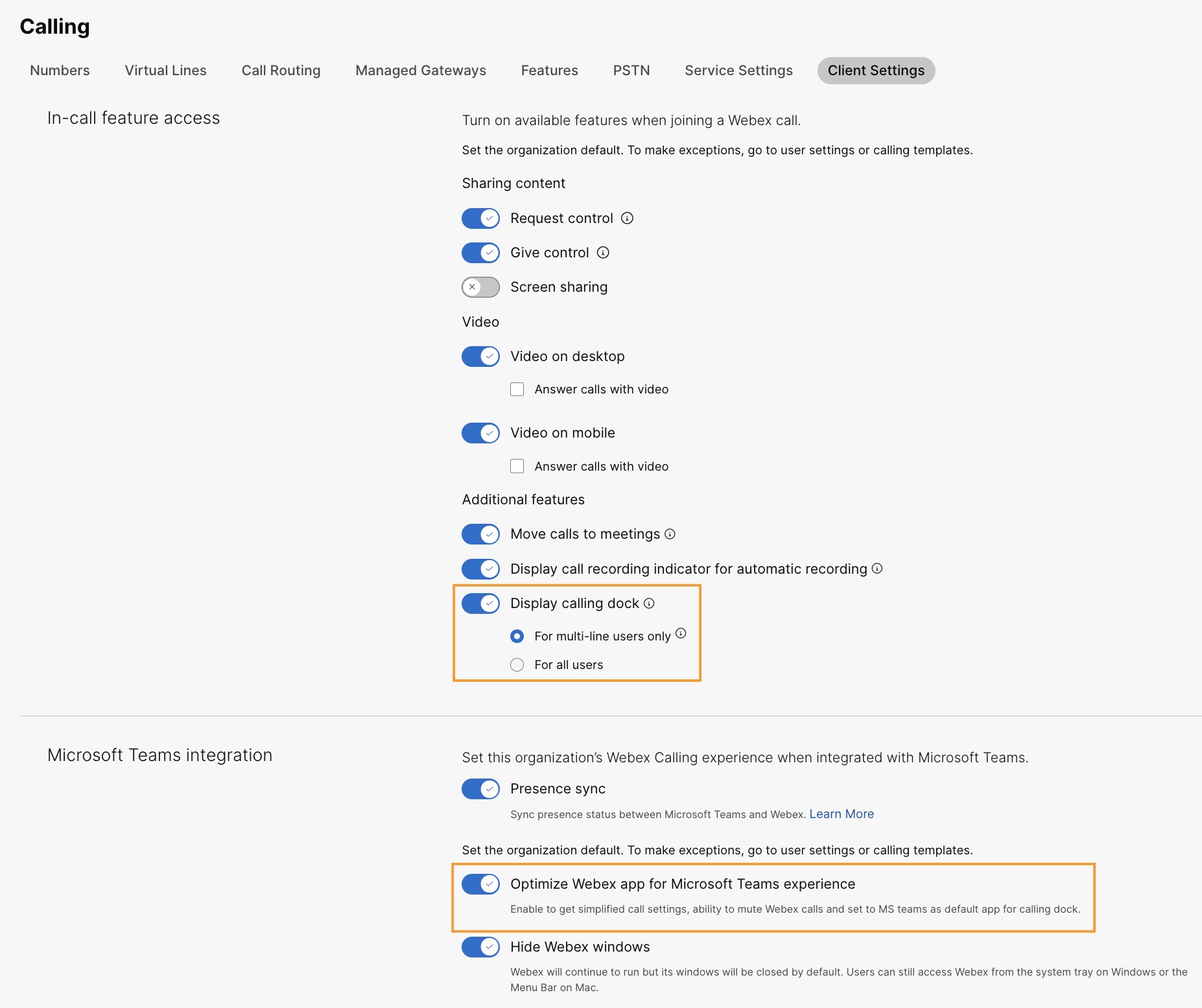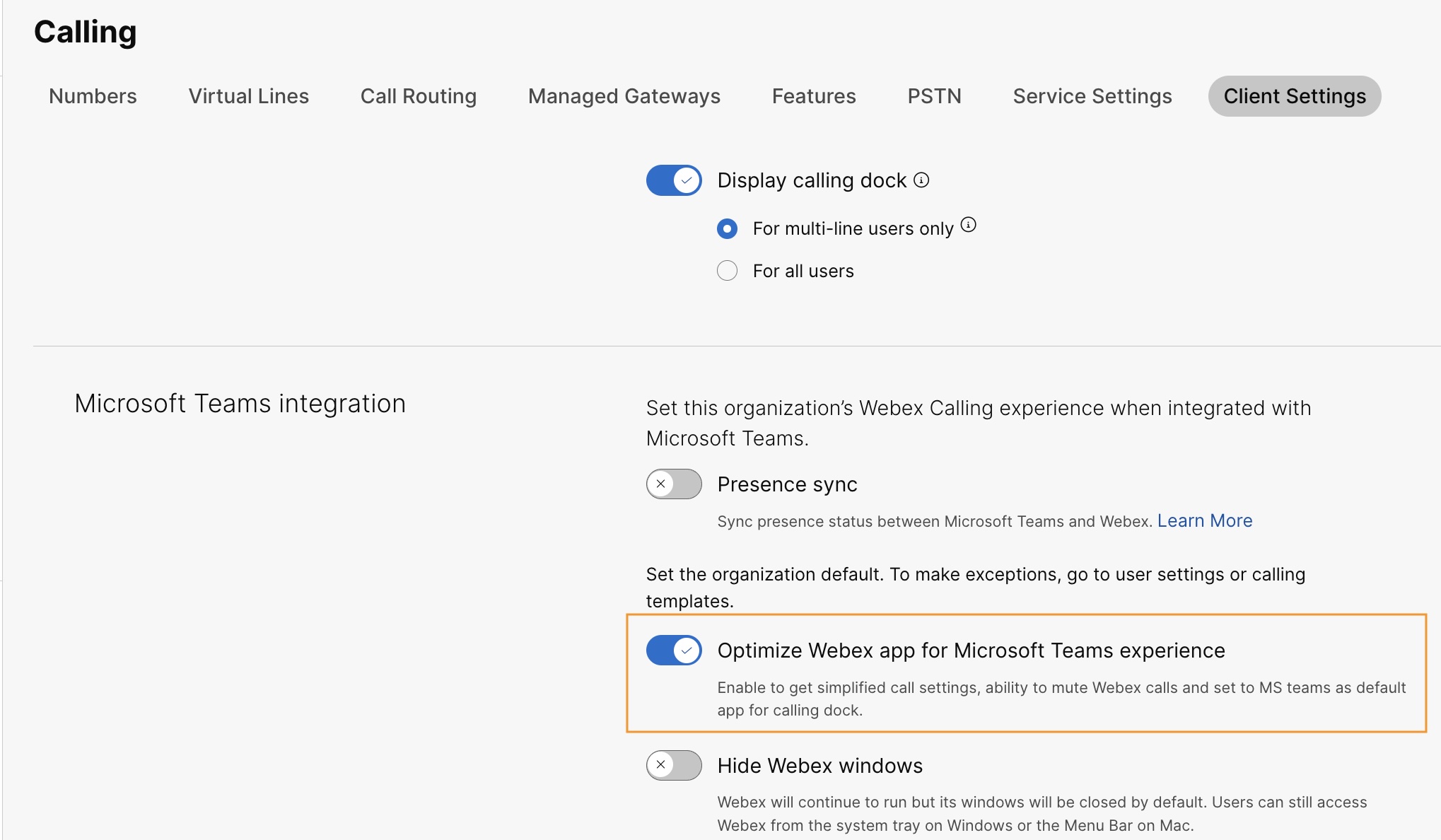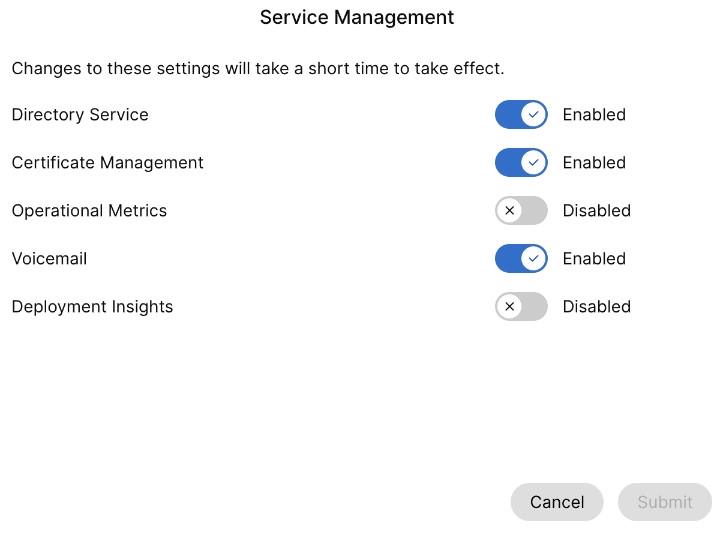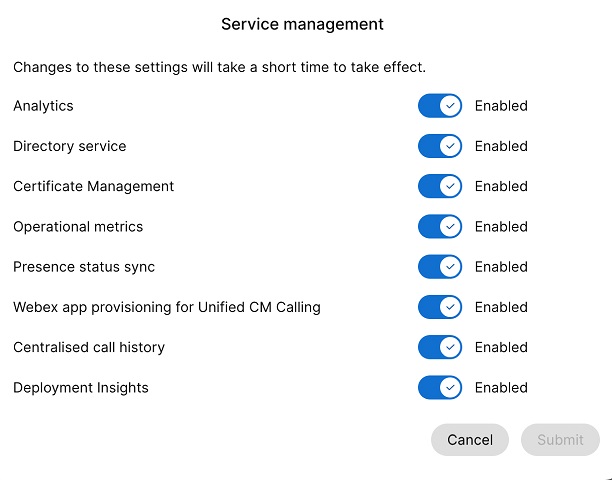- Start
- /
- Artikel



Cisco Call configureren voor Microsoft Teams
 In dit artikel
In dit artikel Feedback?
Feedback?Installeer Cisco Call als standaardbeloptie voor alle gebruikers in uw organisatie.
Gebruik dit artikel om uw Microsoft Teams-app te configureren met Cisco Call-opties. Het pictogram ![]() is toegevoegd aan de linkernavigatie en als een extensie voor Berichten. Als de optie Voor teams bellen is uitgeschakeld, gebruikt iedereen in de organisatie hetzelfde platform om oproepen te maken en te ontvangen.
is toegevoegd aan de linkernavigatie en als een extensie voor Berichten. Als de optie Voor teams bellen is uitgeschakeld, gebruikt iedereen in de organisatie hetzelfde platform om oproepen te maken en te ontvangen.
Voorwaarden
-
Zorg ervoor dat u een Microsoft Teams-beheerder bent.
-
Zorg ervoor dat u toegang hebt tot de Control Hub.
-
Controleer of -gebruikers licentieshebben toegewezen in Control Hub en zich hebben geregistreerd bij Cisco Unified Communications Manager of Webex Calling om te bellen.
-
Gebruikers moeten de Webex-app en Microsoft Teams geïnstalleerd hebben.
-
Om de Cisco Call voor Microsoft Teams-integratie te laten werken met de Unified CM-oproepbeheerbackend (on-premises, Webex Calling Dedicated Instance of UCM Cloud), moet u Unified CM 12.5 SU7 of 14 SU3, Cisco Unity Connection (CUC) 12.5 of 14 gebruiken.
-
Voor On-prem Unified CM-klanten: zorg ervoor dat Unified CM & CUC-clusters worden geïntegreerd in Webex Cloud-Connected UC (CCUC).
-
De gebruikers moeten worden gesynchroniseerd vanuit Active Directory op locatie of vanuit Cloud AD, zoals Azure, naar Control Hub Common Identity (CI).
-
Voor on-premises, Webex Calling Dedicated Instance en UCM Cloud-klanten: Cisco Unified CM configureren— Het lijnnummer op Cisco Unified CM moet worden gekoppeld aan de gebruikers-ID zodat de oproepgeschiedenis wordt gevuld met de gebruikersnaam. Gebruik vanuit Cisco Unified CM AdministrationApparaat→Telefoon, selecteer de telefoon en klik opApparaatnaam (Lijn)en klik vervolgens op de gewenste lijn in het paneelKoppelingom naarGebruiker gekoppeld aan lijnte gaan.
-
Zorg ervoor dat de Unified CM Mail ID overeenkomt met het primaire e-mailadres van de Control Hub dat wordt gebruikt om de Universally Unique Identifier (UUID) te verkrijgen.
-
Virtuele desktopinfrastructuur (VDI): Wanneer Cisco Call-integratie voor Microsoft Teams in een VDI-omgeving wordt gebruikt, moeten Cisco Call en Microsoft Teams op dezelfde virtuele machine worden uitgevoerd.
Microsoft Teams-configuratie
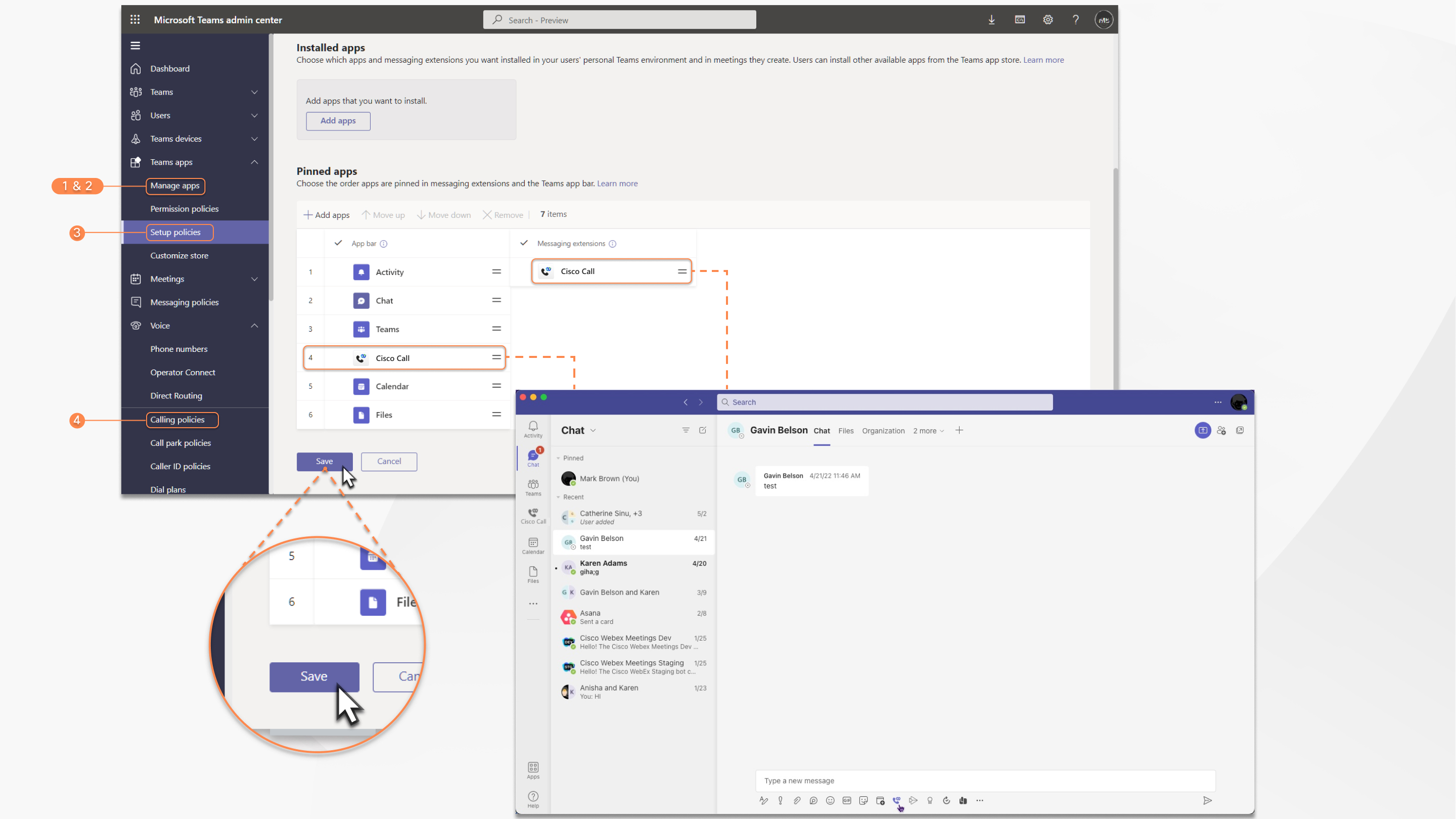
| 1 |
Meld u aan bij het Teams-beheercentrum om uw apps te beheren en Cisco Call toe te staan. |
| 2 |
Beheer wie Cisco Call mag installeren. |
| 3 |
Installeer Cisco Call en voeg het pictogram toe aan de Webex-app. Maak vervolgens de ingebouwde beloptie los. |
| 4 |
Optioneel: schakel de ingebouwde beloptie organisatiebreed uit en maak Cisco Call de enige beloptie:
|
Accepteer aanwezigheidssynchronisatiemachtigingen
Controleer en accepteer de machtigingen voor aanwezigheidssynchronisatie in Microsoft Teams om de aanwezigheidsstatus van de gebruiker bidirectioneel te synchroniseren tussen Microsoft Teams en Webex.
Om de aanwezigheidssynchronisatie te laten werken, moeten gebruikers de Cisco Call-integratie minimaal één keer per 90 dagen gebruiken.
| 1 |
Ga in het menu Dashboard naar |
| 2 |
Voer |
| 3 |
Klik op het tabblad Machtigingen en klik vervolgens op Beheerderstoestemming verlenen. |
| 4 |
Controleer of de volgende machtigingen zijn opgenomen.
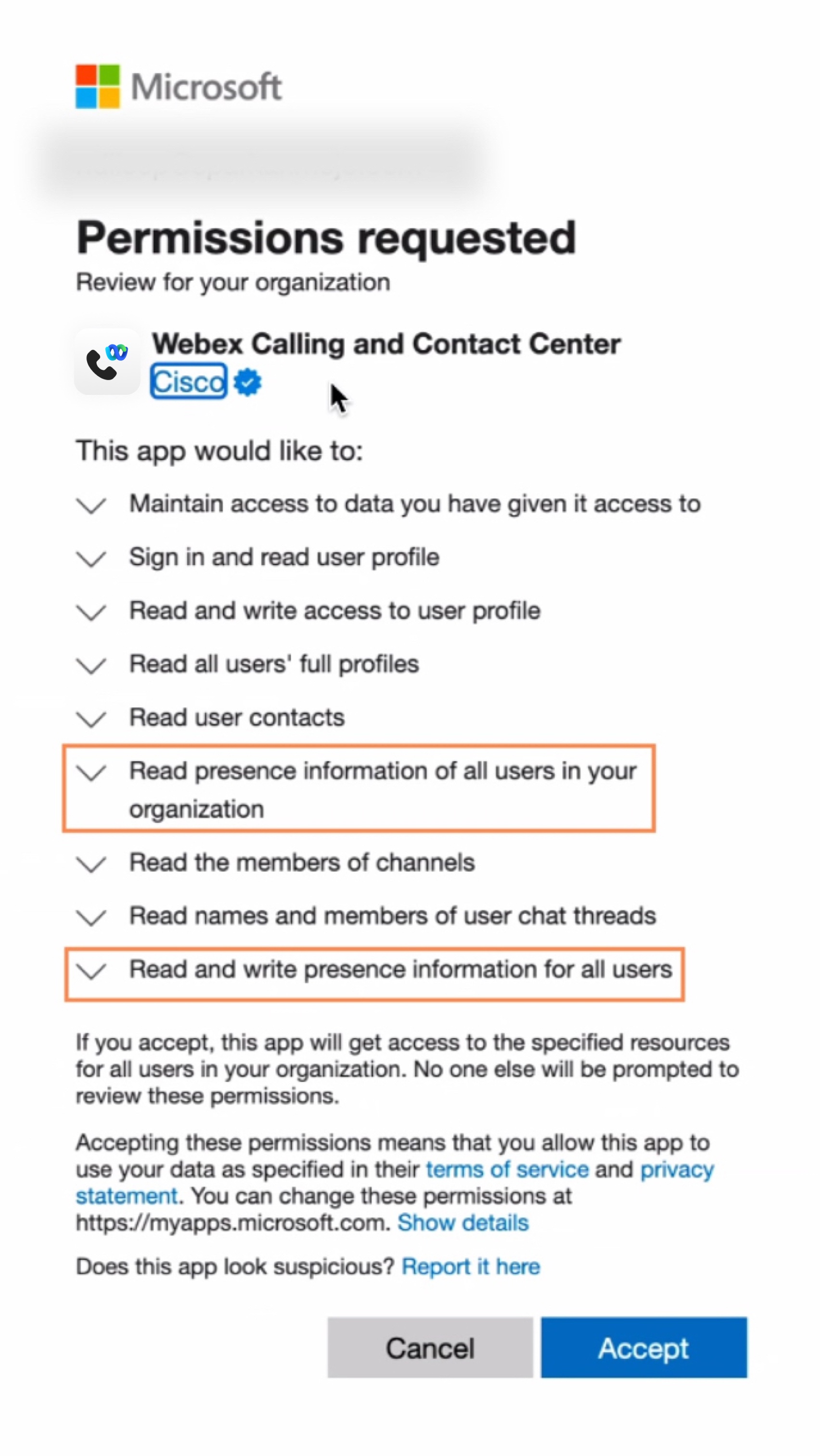 |
| 5 |
Klik op Accepteren om de rechten te accepteren. |
| 6 |
Zorg ervoor dat de nieuwe machtigingen als toegekend worden weergegeven:
De volgende machtigingen moeten in acht worden genomen in de beheerderstoestemming:
Zowel
Als uw organisatie momenteel Als u alleen van Nadat u de machtigingen hebt geverifieerd, schakelt u de aanwezigheidssynchronisatie in de Control Hub in. Raadpleeg het gedeelte Bidirectionele aanwezigheidssynchronisatie inschakelen. Om problemen met de aanwezigheidssynchronisatiestatus tussen Microsoft Teams en Webex te voorkomen, raden we u aan de instelling Toewijzing vereist in te stellen op Nee. Om de instelling bij te werken, gaat u naar het Microsoft Entry-beheercentrum of de Azure-portal en gaat u naar en selecteer Nee. Als u deze instelling om welke reden dan ook op Ja moet laten staan, zorg er dan voor dat u de gebruikers correct toewijst door de stappen te volgen die in de volgende Microsoft-documenten worden genoemd: App-rollen toewijzen aan applicaties & Beheer gebruikers en groepen die aan een applicatie zijn toegewezen. |
Cisco Call-app aanpassen
U kunt de Cisco Call-app voor Microsoft Teams-gebruikers op verschillende manieren aanpassen, afhankelijk van de behoeften van uw organisatie. U kunt een standaardaanpassing van de app maken voor alle gebruikers, of 10 extra aanpassingen van één app maken en deze toewijzen aan specifieke gebruikers of groepen.
Zie Cisco Call-app aanpassen voor Microsoft Teams-gebruikersvoor meer informatie.
Machtigingen voor Cisco Call- en Microsoft Teams-integratie
De integratieservice maakt gebruik van Webex- en Microsoft-API's om toegang te krijgen tot gegevens, zoals de oproepgeschiedenis, voor het weergeven en bijwerken van statussen (bijvoorbeeld het markeren van voicemailberichten als gelezen), zonder dat er gebruikersgegevens worden opgeslagen. Alle gegevensoverdrachten tussen de integratie en de Webex/Microsoft backends vinden plaats via gecodeerde HTTPS-kanalen. De service zorgt er bovendien voor dat gebruikersgegevens niet in de cloud worden opgeslagen, waardoor de privacy en beveiliging van de gegevens worden verbeterd.
We vragen de minimaal vereiste machtigingen van Microsoft om de Microsoft API aan te roepen en zo de integratiefunctionaliteit in te schakelen. In de onderstaande tabel wordt beschreven welke toestemmingen we vragen en waarom deze nodig zijn.
| Toestemming | Reden |
|---|---|
|
offline_access |
Hiermee kan de integratieservice een nieuw toegangstoken genereren zonder dat de gebruiker vaak opnieuw hoeft te autoriseren. |
|
Gebruiker.Lezen |
Hiermee kan de integratieservice de basisgegevens van de gebruiker lezen, zoals het e-mailadres. |
|
Gebruiker.LezenSchrijven |
Hiermee kan de integratieservice snelkiesnummers opslaan in gebruikersprofielen. |
|
Gebruiker.Read.All |
Hiermee kan de integratieservice in de actieve directory naar gebruikers zoeken om gesprekken te voeren. |
|
Contacten.Lezen |
Hiermee kan de integratieservice zoeken naar het Outlook-contactpersoon van de gebruiker om te bellen. |
|
ChannelMember.Read.All |
Hiermee kan de integratieberichtextensie leden van een kanaal lezen, zodat de gebruiker kan zoeken naar een specifiek kanaallid om te bellen. |
|
Chat.ReadBasic |
Hiermee kan de integratieberichtextensie leden van een groepsgesprek voorlezen, zodat de gebruiker kan zoeken naar een specifiek lid om te bellen. |
|
Aanwezigheid.Lezen.Alles |
Hiermee kan de integratieservice de aanwezigheidsinformatie van alle gebruikers in de directory lezen. |
|
Aanwezigheid.LezenSchrijven.Alles |
Hiermee kan de integratieservice alle aanwezigheidsinformatie lezen en de activiteit en beschikbaarheid van alle gebruikers in de directory schrijven. |
|
Aanwezigheid.LezenSchrijven |
Hiermee kan de integratieservice de aanwezigheidsinformatie lezen en de activiteit en beschikbaarheid van een gebruiker schrijven. |
Configuratie van de Control Hub
U kunt de volgende functies in Control Hub configureren en inschakelen om ze beschikbaar te maken voor Microsoft Teams-gebruikers.
Webex-appvenster verbergen
Voor organisaties die ervoor kiezen om de Cisco Call-integratie met Microsoft Teams te gebruiken, is de integratie de primaire gebruikersinterface voor Webex-services. Nadat de Webex-app is geconfigureerd, blijft deze geïnstalleerd en actief op de computers van uw gebruikers, maar het venster is standaard gesloten. Acties die worden uitgevoerd in de Cisco Call-integratie kunnen specifieke functies in de Webex-app starten, maar over het algemeen hoeven gebruikers niet met de Webex-app te communiceren.
Via Control Hub kunt u het Webex-appvenster op de volgende niveaus verbergen:
-
Organisatieniveau
-
Gebruikersgroepniveau
-
Gebruikersniveau
Het Webex-appvenster voor een organisatie verbergen
De instellingen die u op organisatieniveau configureert, worden automatisch toegepast op alle gebruikers binnen de organisatie.
| 1 | |
| 2 |
Ga naar . |
| 3 |
Klik op het tabblad Webex-app, ga naar het gedeelte Microsoft Teams-integratie en schakel Webex-vensters verbergenin.
U kunt ook de openbare API gebruiken om het Webex-appvenster te verbergen voor alle gebruikers in een organisatie die de Cisco Call-integratie met Microsoft Teams gebruikt. Zie De MS Teams-instellingen van een organisatie bijwerken in developer.webex.comvoor meer informatie. |
Het Webex-appvenster voor een gebruikersgroep verbergen
Als u het Webex-appvenster voor een gebruikersgroep wilt verbergen, maakt u een oproepsjabloon en wijst u deze toe aan een gebruikersgroep. De configuratie in de sjabloon is van toepassing op alle gebruikers in de groep.
Een nieuwe sjabloon maken om het Webex-appvenster te verbergen:
| 1 | |
| 2 |
Ga naar . |
| 3 |
Klik op Sjabloon maken, kies Sjabloon maken en klik op Volgende. Als onderwijs uw bedrijfstak is, kunt u vooraf gedefinieerde sjablonentoepassen met aangepaste instellingen voor studenten of docenten. |
| 4 |
Typ in het gedeelte Algemeen de Sjabloonnaam en Beschrijving. |
| 5 |
Ga naar het gedeelte Microsoft Teams-integratie en schakel Webex-vensters verbergenin. |
| 6 |
Klik op Sjabloon maken en daarna. |
| 7 |
Zoek en selecteer een groep voor deze sjabloon en klik op Gereed. Een sjabloon wijzigen of verwijderen:
Om een sjabloon te wijzigen, klikt u op de sjabloon, wijzigt u de schakelaars en klikt u op Opslaan. Om een sjabloon te verwijderen, klikt u op de sjabloon en kiest u Verwijderen in de vervolgkeuzelijst Acties. Vink op de pagina ] Sjabloon verwijderen het vakje aan dat aangeeft dat het verwijderen van een sjabloon definitief is en klik vervolgens op Verwijderen. |
Overwegingen bij het toepassen van oproepsjablonen op een gebruikersgroep
-
Als een gebruiker is geïntegreerde bij een organisatie, neemt de gebruiker de instellingen over van het organisatieniveau.
-
Als de gebruiker aan een gebruikersgroep wordt toegevoegd, zijn de instellingen in het Belsjabloon van toepassing.
-
Als een gebruiker tot meerdere gebruikersgroepen behoort, heeft de sjabloon met de hoogste rang (rang 1) de hoogste voorrang en worden de instellingen van die sjabloon toegepast.
-
Als de gebruiker individuele gebruikersinstellingen heeft, hebben deze instellingen voorrang op instellingen op gebruikersgroep- of organisatieniveau.
Zie Instellingensjablonen configureren voor meer informatie over het beheren van uw sjablonen.
U kunt de bestaande sjabloon toepassen vanuit de sectie Groep of de sectie Aanroepen.
- Voor het toepassen van een sjabloon uit de sectie Groep, zie Sjabloon voor instellingen configureren.
- Om u aan te melden via het gedeelte Oproepen, volgt u de onderstaande stappen.
| 1 | |
| 2 |
Ga naar . |
| 3 |
Klik op |
| 4 |
Typ de naam van de groep waarop u de sjabloon wilt toepassen en kies vervolgens de groep. |
| 5 |
Klik op Gereed. |
Het Webex-appvenster voor een gebruiker verbergen
De individuele gebruikersinstellingen overschrijven de instellingen op organisatie- en gebruikersgroepniveau.
| 1 | |
| 2 |
Ga naar . |
| 3 |
Selecteer een gebruiker en klik op Bellen. |
| 4 |
Ga naar Gebruikersoproepervaring en klik op Microsoft Teams-integratie. |
| 5 |
Schakel Webex-vensters verbergenin. 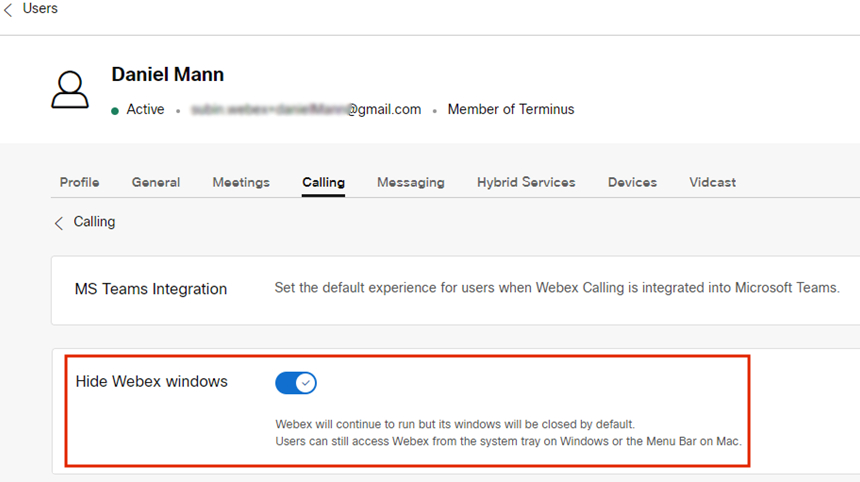 Nadat u de instellingen voor een gebruiker hebt geconfigureerd, kunt u de instellingen op gebruikersniveau verder wijzigen. Gebruikersinstellingen worden niet automatisch teruggezet naar de standaardinstellingen van een organisatie. U kunt de openbare API gebruiken om het Webex-appvenster te verbergen in de Microsoft Teams-client voor een individuele gebruiker. Zie De MS Teams-instellingen van een persoon configureren en De Application Service-instellingen van een persoon ophalen in developer.webex.com. |
Nadat u de instellingen hebt geconfigureerd, moeten gebruikers hun Webex-app opnieuw starten en zich aanmelden om de wijziging te bekijken.
Als gebruikers met de Webex-app zelf willen communiceren, kunnen ze dit doen via het systeemvak in Windows en de menubalk op Mac. De Webex-app is alleen zichtbaar in de Windows-taakbalk of het macOS-dock wanneer een venster actief en in gebruik is.
|
Webex-app in het systeemvak van Windows |
Webex-app in Mac-menubalk |
Dock-venster voor oproepen inschakelen
Het oproepdockvenster (multicall) is een apart, zwevend venster waarmee gebruikers meerdere of gedeelde lijnen in één venster kunnen beheren. Gebruikers kunnen bellen en gebeld worden, de status van alle lijnen bekijken en hebben betere toegang tot functies zoals in de wacht zetten, doorverbinden en inbreken, zonder dat ze naar een ander venster hoeven te gaan.
| 1 | |
| 2 |
Ga naar . |
| 3 |
Klik op het tabblad Webex-app, ga naar het gedeelte Toegang tot functies tijdens gesprek en schakel onder Extra functiesde optie Oproepdock weergeven in en kies een van de volgende opties:
U kunt deze functie ook configureren op gebruikersgroep- en gebruikersniveau.
|
Optimaliseer de Webex-app voor Microsoft Teams-ervaring
Deze functie biedt gebruikers de volgende ervaringen:
-
Vereenvoudigde oproepinstellingen: in de oproepinstellingen worden alleen de opties weergegeven die nodig zijn voor integratie. Als u deze functie inschakelt, worden alleen de oproepinstellingen die via het oproepdock toegankelijk zijn, vereenvoudigd. De oproepinstellingen die toegankelijk zijn via de Cisco Call-integratie blijven standaard vereenvoudigd.
-
Cisco-oproepen dempen: de inkomende Cisco-oproepen worden gedempt wanneer een gebruiker deelneemt aan een Microsoft Teams-oproep of -vergadering. Om deze functie te laten werken, moet u deze functie inschakelen in Control Hub en moet de gebruiker de optie Alleen meldingen dempen wanneer ik in een vergadering of gesprek ben inschakelen in de gespreksinstellingen in Cisco Call Integration.
Als u deze functie in Control Hub uitschakelt, werken de gebruikersinstellingen alleen wanneer de gebruiker zich in een Cisco-gesprek of -vergadering bevindt. Als u deze functie inschakelt, werken de gebruikersinstellingen wanneer de gebruiker zich in een Microsoft Teams-gesprek of -vergadering of een Cisco-gesprek of -vergadering bevindt.
-
Ervaring met één app: wanneer een gebruiker op de pictogrammen voor voicemail en oproepgeschiedenis klikt in het oproepdock, wordt hij of zij doorgestuurd naar de Cisco Call-app van Microsoft Teams in plaats van naar de Webex-app.
Voor Windows-gebruikers: Wanneer u op de Webex-app in het systeemvak klikt, wordt het oproepdock geopend in plaats van de Webex-app.
| 1 | |
| 2 |
Ga naar . |
| 3 |
Klik op het tabblad Webex-app, ga naar het gedeelte Microsoft Teams-integratie en schakel Webex-app optimaliseren voor Microsoft Teams-ervaringin.
Deze schakelaar is uitgeschakeld als u de schakelaar Weergave oproepdock niet hebt ingeschakeld onder het gedeelte Toegang tot functies tijdens gesprek. U kunt deze functie ook configureren op gebruikersgroep- en gebruikersniveau.
|
Voicemail, oproepgeschiedenis en aanwezigheidssynchronisatie inschakelen
Voicemail en oproepgeschiedenis
De voicemail- en oproepgeschiedenisfuncties zijn standaard ingeschakeld voor klanten van Webex Calling, Dedicated Instance en UCM Cloud.
Voor meer informatie over het inschakelen van voicemail voor Webex Calling-gebruikers, zie: Voicemailinstellingen voor een Webex Calling-gebruiker configureren en beheren.
Zie Voicemail inschakelen voor Microsoft Teams-integratievoor meer informatie over het inschakelen van voicemail voor BroadWorks-gebruikers.
BroadWorks-beheerders moeten Unified Gespreksgeschiedenis inschakelen om ervoor te zorgen dat deze functie correct werkt. Zie De configuratiehandleiding van Webex voor Cisco BroadWorks voor meer informatie.
Bidirectionele aanwezigheidssynchronisatie
Met deze functie is bidirectionele synchronisatie van de aanwezigheidsstatus tussen Microsoft Teams en Webex mogelijk. Hiermee worden meerdere Microsoft Teams-tenants in dezelfde Webex-organisatie ondersteund. De aanwezigheidsstatus omvat In gesprek, In vergadering, Presenterenden Niet storen.
Nadat deze functie is ingeschakeld, wordt de Microsoft Teams-status van een gebruiker gewijzigd naar In gesprekwanneer hij of zij een Webex-oproep maakt of ontvangt. Wanneer ze Niet storen inschakelen in de Webex-app of op een ander Webex-apparaat, wordt de status automatisch gesynchroniseerd met Microsoft Teams. Op dezelfde manier worden de statussen In een vergadering en Presenteren gesynchroniseerd tussen applicaties.
Wanneer Niet storen is ingeschakeld in de Webex-app van de gebruiker of op een ander Webex-apparaat, ontvangt de gebruiker geen meldingen van inkomende oproepen en berichten in de Webex-app, het Webex-apparaat of Microsoft Teams.
U kunt ook een openbare API gebruiken om Webex-aanwezigheidssynchronisatie met de Microsoft Teams-client in te schakelen. Zie De MS Teams-instellingen van een organisatie bijwerken in developer.webex.comvoor meer informatie.
De volgende tabel toont de bidirectionele weergave van statussynchronisatie tussen Webex en Microsoft Teams.
|
Webex-status |
Microsoft Teams-status |
|---|---|
|
|
|
|
|
|
|
|
|
|
|
|
Momenteel kunt u deze functie alleen op organisatieniveau configureren.
| 1 | |
| 2 |
Ga naar . |
| 3 |
Klik op het tabblad Webex-app, ga naar het gedeelte Microsoft Teams-integratie en schakel Aanwezigheidssynchronisatiein. U kunt de schakelaar Webex-vensters verbergen inschakelen voor de beste ervaring, maar dit is optioneel. |
| 4 |
Ga naar het gedeelte Niet storen (DND)-statussynchronisatie en zet de schakelaar aan. 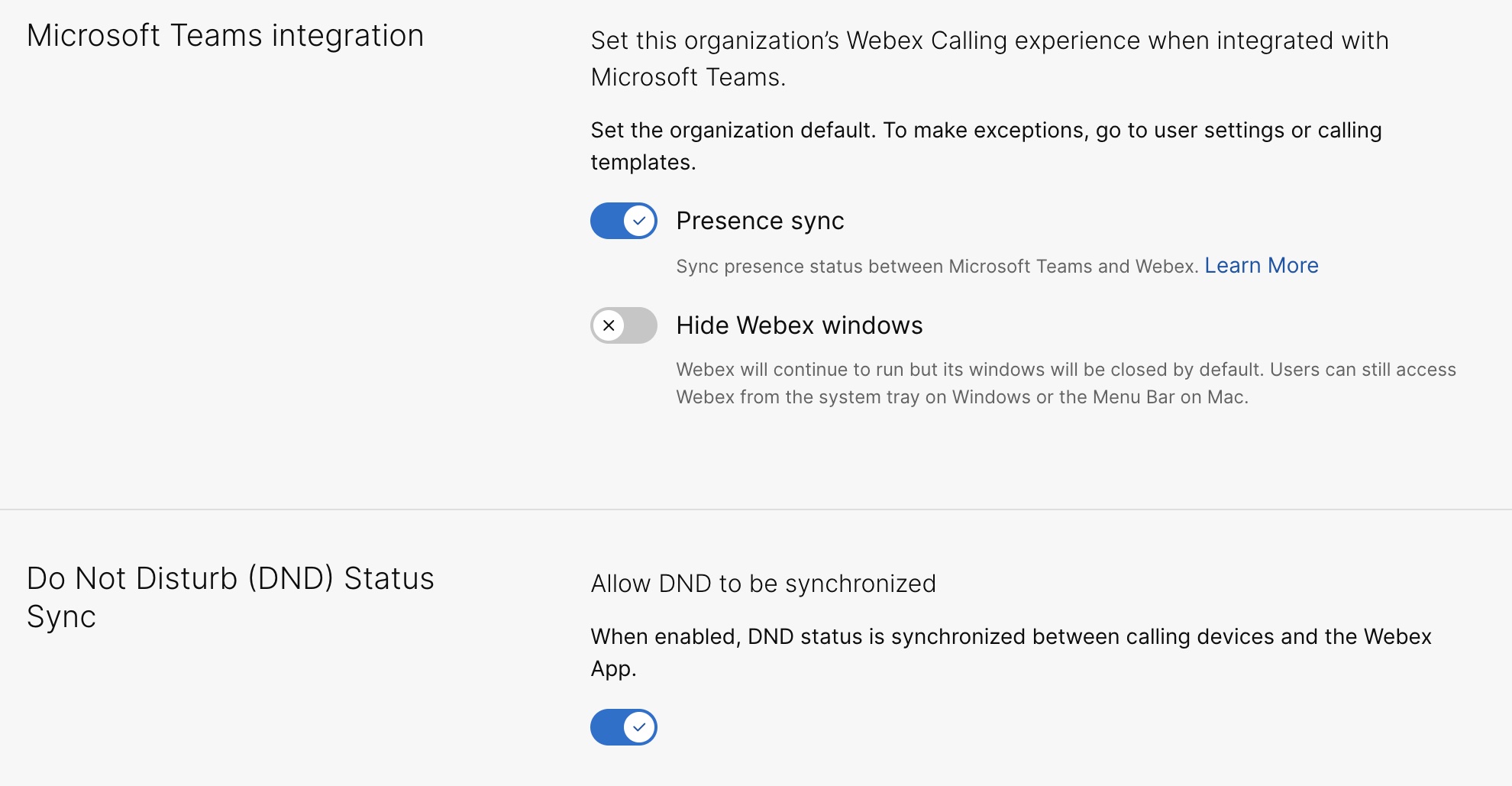 |
Extra configuratie voor Unified CM-gebruikers
Voer de volgende stappen uit om voicemail, oproepgeschiedenis en bidirectionele aanwezigheidssynchronisatie in te schakelen voor on-prem Unified CM-klanten:
Het duurt maximaal 12 uur voordat de voicemailservice voor on-prem-klanten is geactiveerd.
| 1 | |||||
| 2 |
Ga naar . Klik op de kaart UC-beheer op Inventaris. De lijst met clustergroepen wordt weergegeven met de beschrijving, status, clusters en knooppunten. | ||||
| 3 |
Voer de volgende acties uit:
De pagina Inventaris wordt weergegeven met de lijst met clusters die bij de geselecteerde clustergroep horen. | ||||
| 4 |
Klik op Details naast het cluster waartoe het specifieke productknooppunt behoort. De naam van het knooppunt met de versie, het product en de status wordt weergegeven. | ||||
| 5 |
Klik op het ellipsvormige ⋮-pictogram naast Evenementgeschiedenis en kies Servicebeheer. De pagina Servicebeheer wordt weergegeven met de lijst met services. | ||||
| 6 |
Gebruik de wisselknop om Voicemail, Gecentraliseerde oproepgeschiedenis en Synchronisatie van aanwezigheidsstatusin te schakelen.
| ||||
| 7 |
Klik op Verzenden. | ||||
| 8 |
Als het pop-upvenster Bevestiging gegevensverzameling wordt weergegeven, gaat u hiermee akkoord door het selectievakje in te schakelen en op Verzendente klikken. |

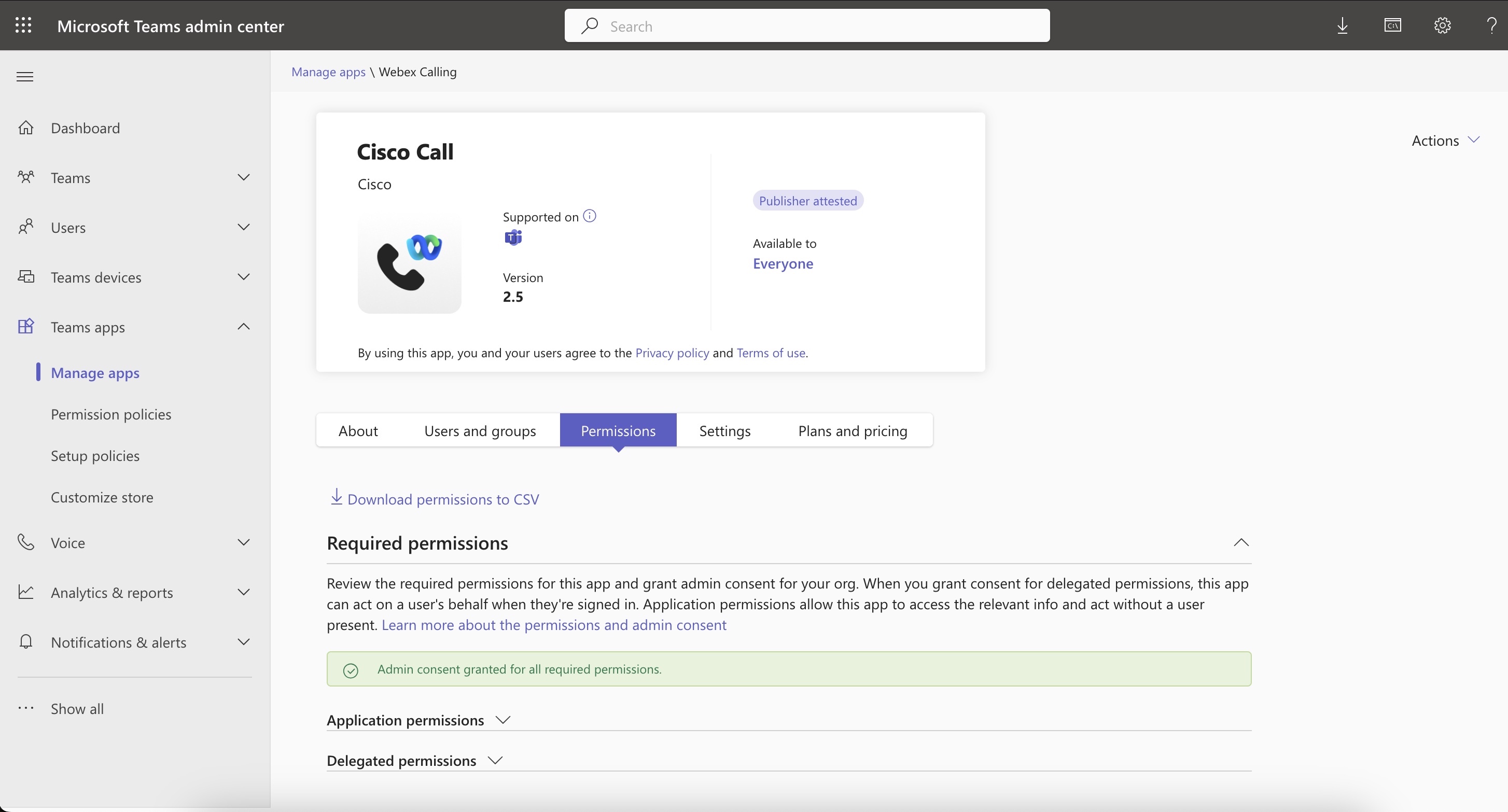
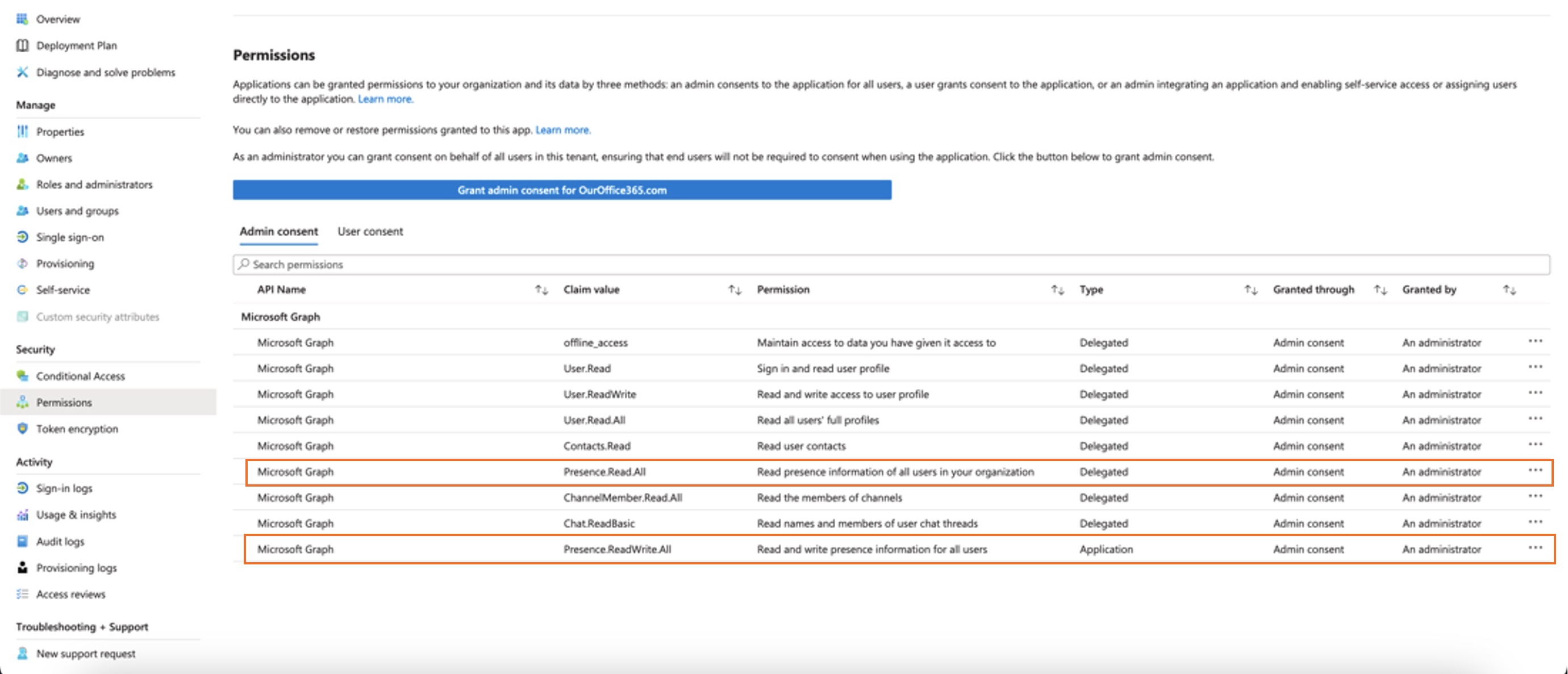
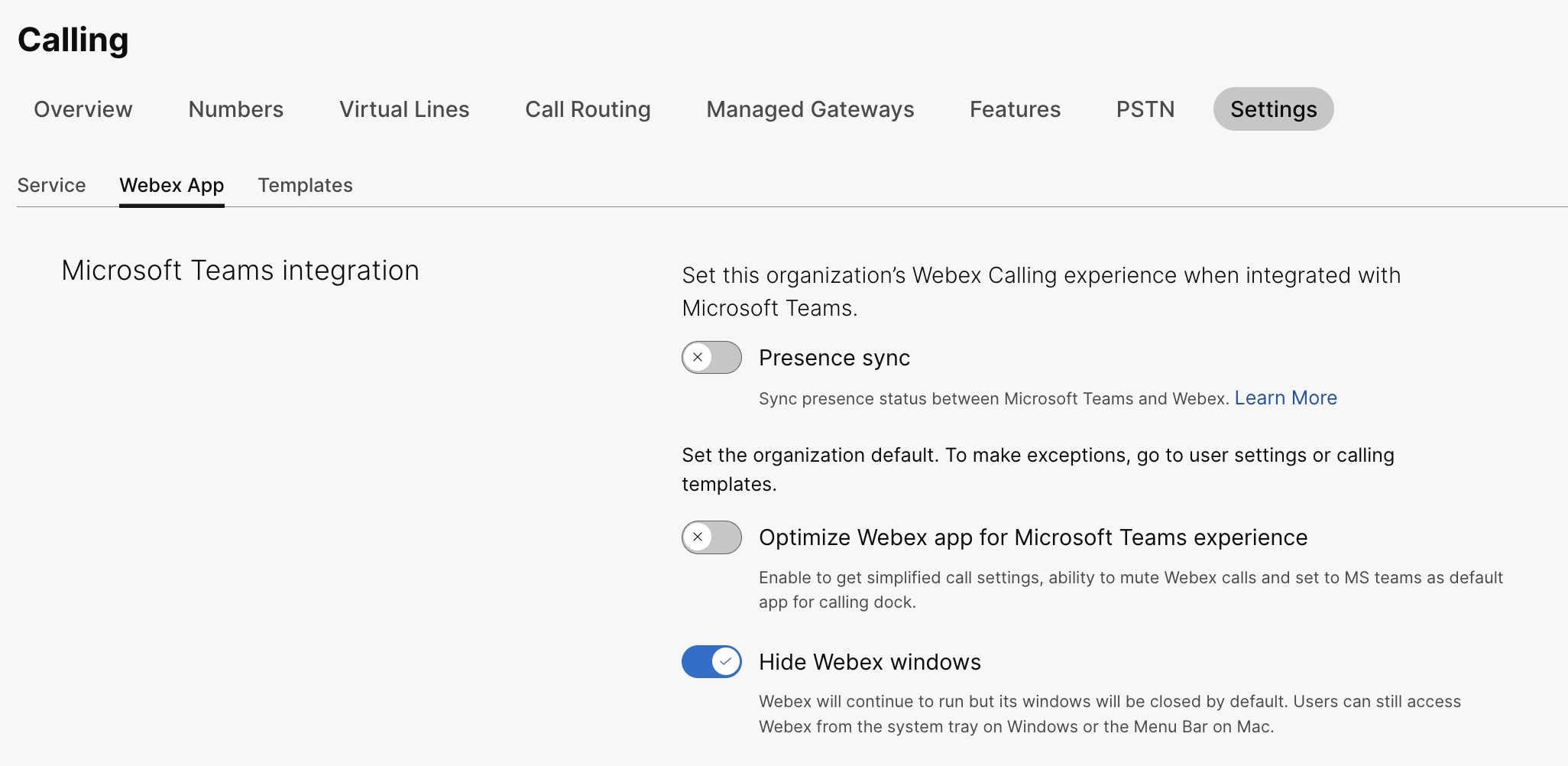
 naast een bestaande sjabloon en klik op
naast een bestaande sjabloon en klik op 